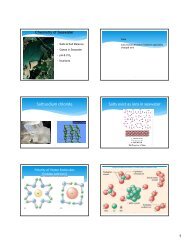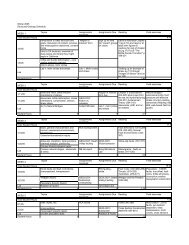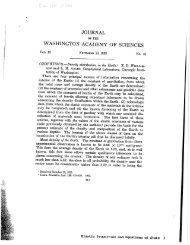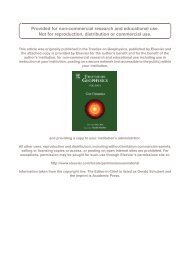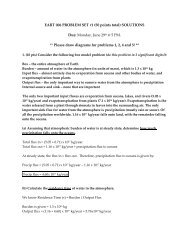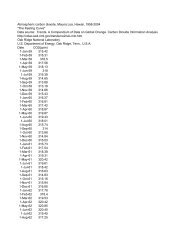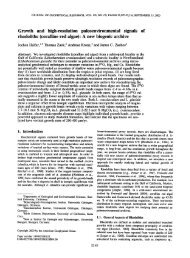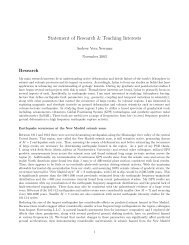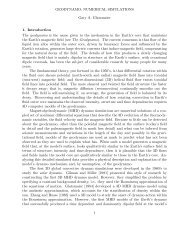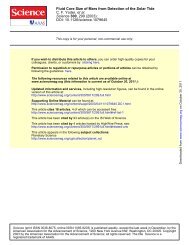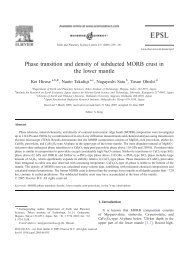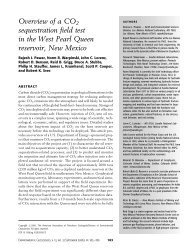From Greenhouse to Icehouse – The Eocene/Oligocene - UMass ...
From Greenhouse to Icehouse – The Eocene/Oligocene - UMass ...
From Greenhouse to Icehouse – The Eocene/Oligocene - UMass ...
Create successful ePaper yourself
Turn your PDF publications into a flip-book with our unique Google optimized e-Paper software.
328 J. E. Francis et al.<br />
Author's personal copy<br />
Hemisphere angiosperm families, including the Proteaceae, Myrtaceae and<br />
Lauraceae, are also represented. <strong>The</strong> macrofossil record has largely been<br />
described from isolated collections, even of single leaves in cores, and<br />
although reasonably dated as a whole, a comprehensive understanding of<br />
stratigraphic relationships between the floras, particularly in the Antarctic<br />
Peninsula region, is at present hampered by differing stratigraphic<br />
interpretations.<br />
8.3.2. Antarctic Peninsula: King George Island<br />
Many macrofloras have been discovered on King George Island in the South<br />
Shetland Island group, north of the Bransfield Strait in the Antarctic<br />
Peninsula region, currently dated between Late Palaeocene and Late <strong>Eocene</strong><br />
in age. <strong>The</strong> floras may have lived at a palaeolatitude of B621S, similar <strong>to</strong> its<br />
present-day location (Lawver et al., 1992). <strong>The</strong> stratigraphy is complex<br />
because Birkenmajer (1981, 1989, 1990) and Birkenmajer et al. (1986) erected<br />
many local formations in comparison <strong>to</strong> a simpler scheme created by Smellie<br />
et al. (1984). No single stratigraphic scheme exists and so the relationship<br />
between the floras is confusing. <strong>The</strong> stratigraphic framework used here<br />
includes both schemes (also reviewed by Hunt, 2001). Leaf macrofloras,<br />
currently unders<strong>to</strong>od <strong>to</strong> be of Late Palaeocene <strong>to</strong> Middle <strong>Eocene</strong> in age, have<br />
been described in varying completeness from the Admiralty Bay and Fildes<br />
Peninsula areas of the island.<br />
In the Admiralty Bay area, the Middle <strong>Eocene</strong> Mt. Wawel Formation<br />
(Point Hennequin Group) contains the macroflora deposits collectively<br />
known as the Point Hennequin Flora with individual localities named Mount<br />
Wawel and Dragon Glacier Moraine floras (Zastawniak et al., 1985;<br />
Birkenmajer and Zastawniak, 1989a; Askin, 1992; Hunt, 2001; Hunt and<br />
Poole, 2003). <strong>The</strong> Mount Wawel flora comprises macrofossils of Equisetum<br />
(horsetail), ferns and several Nothofagus species as microphyllous leaves<br />
(a leaf-size category of 2.5<strong>–</strong>7.5 cm long), in addition <strong>to</strong> a few other<br />
angiosperms and Podocarpaceae. <strong>The</strong> Dragon Glacier Moraine flora is<br />
similar, the angiosperm leaves being dominated by Nothofagus and the<br />
conifers including Araucariaceae and Cupressaceae, in addition <strong>to</strong> Podocarpaceae.<br />
<strong>The</strong> Middle <strong>Eocene</strong> Petrified Forest Creek flora from the<br />
Arc<strong>to</strong>wski Cove Formation and the Late <strong>Eocene</strong> Cytadela flora from<br />
the Point Thomas Formation are both within the Ezcurra Inlet Group. <strong>The</strong><br />
former is a wood flora requiring revision, but intermediate Fagus<strong>–</strong><br />
Nothofagus-type species are recorded. <strong>The</strong> Cytadela leaf flora includes<br />
ferns (including a Blechnum-affinity species), mostly small Nothofagus-type



